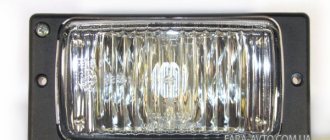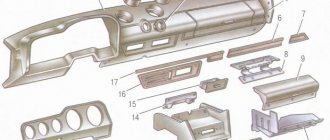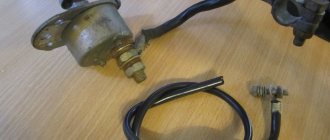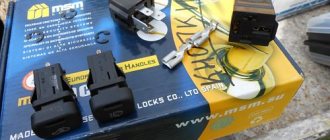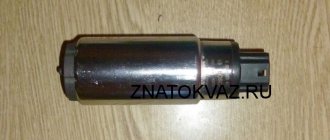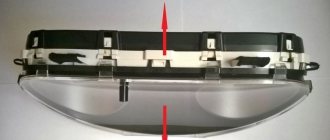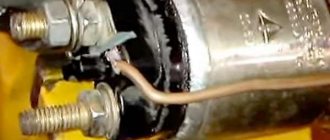I was prompted to write this article by another incident when I needed to use “lighting” - to start the engine from the battery of another car. Every time I do this I am faced with the illiteracy of other drivers. And this time, when I reasonably explained why and how to do it, the driver said that he was an electrician. I didn’t argue, let him be an electrician...
So, there are two main misconceptions when lighting a cigarette: 1. You must connect the minus (ground) first, then the plus. 2. Apply the gas (keep the speed above XX) when starting another car.
Let's deal with the first one. I always wondered why they so insistently wanted to connect the masses first. All I hear in response is “well, that’s a lot.” The last time I received the answer “I’m an electrician”) In fact, for low-voltage car networks, there is no difference what to connect first - plus or minus. Moreover, the cars are reliably isolated from each other by the thickness of their rubber tires. You can safely connect the positive terminals of the battery first. The advantage of the connection sequence, first plus, then minus, is security. If you first connect the minus (mass), then everything they say is true, the mass of the cars becomes common, all the hardware of both cars becomes connected to the minuses of both batteries. Therefore, when you then connect the positives, you need to be very careful; accidentally touching the positive wire with a loose clamp on any hardware of both machines will cause a short circuit and decent fireworks. With or without consequences, depending on your luck. If you connect the plus before combining the masses, then everything is much simpler. One end of the wire (positive) is led out of the car in advance to which the wire will be connected first. Then it is freely connected to the positive of the second car without fear of touching its iron (ground). The masses of the cars are not yet connected, there will be no short circuit. Then the negative (we connect ground) wire is connected without any worries. To create a short circuit with such a sequence, you need to make a special effort.
Second misconception. It is believed that if you apply the throttle (keep the revs up) while trying to start, the second car will start better. In principle this is true, the generator will add several hundred watts. Perhaps, as a last resort, this option will be the only one. But unless the case is extreme, why subject the generator to a load for which it is not designed? During a cold start, the starter can draw hundreds of amps. Generators and wiring of passenger cars are not designed for such currents. And the more revolutions you add when trying to start, the more the generator will be loaded. Burnt diodes in a generator can be easily obtained. Therefore, it is better to try to start the second car by completely turning off the engine. Before starting, of course, you can let the generator run to charge the battery of the car being started. Then turn it off and try to start it.
Bottom line. “Lighting up” correctly: 1. First connect the car batteries with the positive wire, then connect the ground. 2. Without special need, we do not keep the car running while starting the second car, and especially do not apply gas.
In the Other Auto Topics to the question Question for backfilling)) Why is the “ground” switched off in cars, i.e.? is it a minus, not a plus? given by the author Vasya, the best answer is I’m really bad at math)) ) Pros and cons - I don’t understand anything)) Source: Hello, dear))
The battery mass is usually represented by the negative terminal. To be technically correct, the battery has no mass, the car has mass.
In modern cars, the mass is attached to the negative terminal of the battery. The reason for this is that when the battery mass was positive, the body wore out (corroded) faster. On all batteries, the mass (negative terminal) is smaller in size than the positive terminal and is indicated by the sign “-“.
If your car's ground terminals are heating up, most likely the reason lies in poor contact. If the battery ground terminal gets hot, do the following:
1) Remove the ground terminal (negative) from the battery, sand the inside of the terminal and the battery pole terminal until the lead is shiny.
2) Check if your battery terminals are properly lubricated.
3) Install the ground terminal to the negative terminal of the battery. Tighten gently.
If heating of the ground terminal continues, contact a specialized car service center.
A battery is a chemical source of current, for which certain chemical processes must occur to function properly. As the battery discharges, sulfuric acid “sticks” to the negative electrode, forming insoluble lead sulfate, leaving
Very often you can hear recommendations about hybrid batteries from salespeople in car dealerships. So what is a hybrid battery? A hybrid battery for a car is externally indistinguishable from other acid batteries, except for the ethical designation
Every motorist sooner or later becomes interested in the design of a car battery and the principle of its operation. A car battery serves as the heart of any modern car - thanks to it we start the engine, listen to music in the car.
The battery mass is usually represented by the negative terminal. To be technically correct, the battery has no mass, the car has mass.
In modern cars, the mass is attached to the negative terminal of the battery. The reason for this is that when the battery mass was positive, the body wore out (corroded) faster. On all batteries, the mass (negative terminal) is smaller in size than the positive terminal and is indicated by the sign “-“.
If your car's ground terminals are heating up, most likely the reason lies in poor contact. If the battery ground terminal gets hot, do the following:
Additional ground (wires)
If the weight of the engine with the body is bad, then problems arise:
- The battery may not charge well;
- The starter turns poorly when starting the engine, or may not turn at all, only the solenoid relay will click;
- At full power consumption (high beam headlights on, heater motor running, etc.), the generator may not be charging enough.
When symptoms of poor engine mass appear, there is a way out of the unpleasant situation - in this case, additional mass on the engine will help. You can install an additional wire in different ways, the most important thing is that it reliably connects the car body with the power unit. For example, one end of the wire can be attached to the stud of the upper shock absorber support, and the other to the stud of the intake manifold of the internal combustion engine
It is important that the wire has a large cross-section, preferably no less than that of the bulk itself
On new machines, problems with mass wires rarely occur. But on older models, the body studs rust. Finding a lack of ground is not so easy, so car owners use the installation of additional wires. So the additional mass on the generator helps eliminate battery charging leakage.
An additional wire is a necessity on used cars
Poor weight causes unstable engine operation. For example, a weak mass with the ECU affects the stability of the engine at idle speed. There is a loss of voltage in the circuit, and when the electric engine cooling fan is turned on, the idle speed drops noticeably, sometimes even to the point of stopping the internal combustion engine. Therefore, contact must be established and a reliable ground must be established. The problem on the new generation VAZ 2113-15 is also solved by installing an additional thick bulk wire (about 2.5 mm²) - it stretches from the negative terminal of the battery to the metal base of the center console in the car interior
Unreliable contact of the common wire of the instrument panel can affect the readings of sensors installed on the combination. In particular, when the dimensions are turned on, the arrows of the fuel level and coolant temperature indicators may deviate. It also happens that the instrument cluster is dimly lit. Behind the instrument panel itself there is a standard bolt for securing the ground; perhaps the fastening has become loose. You need to remove the shield and tighten the bolt.
Installing an additional wire from the negative of the cigarette lighter to the metal frame of the center console sometimes also solves the problem, and the instruments begin to display correctly.
How to check mass on a car
In fact, only a small group of motorists pay enough attention to this issue. Others begin to think about it when, when the cooling fan or headlights are turned on, the engine speed begins to sag, or when the rear window heating is turned on, the engine begins to tremble, transmitting vibration throughout the body.
But even at this stage, many limit themselves to a banal inspection and tightening the ground connection nuts on the engine and body. Everything is screwed down - that means everything is in order.
Then the car begins to jerk for no apparent reason, idle speed freezes, misfires, security system glitches, and so on, until the starter fails at the most inopportune moment. But even here, many will not go check the masses, but will run to the store for a new starter. After all, the wire to the starter is intact and there is voltage, but it, a radish, does not turn.
Replacing the starter, of course, does not help. As a result, the still-living battery goes into recycling and the situation seems to have improved, but after a couple of days the starter fails again and you begin to believe in brownies and otherworldly forces that have nothing better to do than cause damage to someone else’s car.
But, fortunately, reason wins and the advice of a good man is remembered - to check the masses.
Again, what's so difficult about this? It is necessary to check the resistance from the engine to the body.
How to extend battery life - 6 useful tips for battery maintenance
This can be achieved by properly caring for the battery and following simple rules.
- If you have a serviceable battery, then perform its maintenance once a year, which consists of adding distilled water to the jars. It must be remembered that lead plates should never be dry. So, your battery can be checked much more often.
- Keep both the battery itself and the battery terminals clean. If oxides begin to collect on the terminals, they need to be removed from the battery and cleaned with sandpaper.
- When starting in winter, on cars equipped with a manual transmission, you must depress the clutch, so when starting, the starter turns only the engine without a gearbox. And this requires much less energy.
- Also, when starting in winter, it is recommended to warm up your battery. To do this, you need to turn the high beams on and off for a short time before starting.
- Also, when operating a car in winter, especially in cases where the mileage is short, find a way to recharge your battery using a charger, since with short mileage it does not have time to charge.
- Make sure that the battery is securely fastened, as it does not tolerate vibration well and may fail prematurely because of this.
By following these simple rules, you will achieve maximum service life for your battery.
Additional Weight: Benefits
Engine demining for the purpose of improvement has both supporters and opponents of this method. Skeptics consider this solution a waste of time and money, citing the fact that standard solutions in the car are quite sufficient, the cross-section of the factory wires is sufficient, each sensor has its own separate negative ground (sensor ground), etc.
The main argument among those who have already implemented the procedure is the stability of spark formation and operation of the entire ignition system as a result of the most efficient and reliable mass in the car. It is also claimed that the mass becomes even for all devices that consume electricity. Such uniform distribution cannot be achieved with standard mass, even if the terminals are cleaned regularly. The list of main advantages of power engine demining includes:
- fuel savings at a minimum level of 5-7% or more are achieved due to the fact that the generator is unloaded and the resistance is reduced;
- the starter rotates the crankshaft more actively at low temperatures at the time of start-up;
- the engine runs more smoothly and smoothly after de-mining;
- the power plant responds better to the gas pedal;
- the motor produces more power;
- the battery lasts longer and is recharged more efficiently from the generator;
- engine vibrations disappear when powerful consumers are turned on (air conditioning, increasing the music volume when using external amplifiers, etc.);
This modification makes it easier to start the car and increases the stability of speed in idle mode (the speed does not fluctuate). It was also noted that after the diesel or gasoline engine has been de-energized, headlights begin to shine brighter, increasing the comfort and safety of movement at night. Additionally, it is worth noting that after de-mining, interference and interference are minimized or completely eliminated, and music from the media and radio in the car’s speaker system begins to play clearer. Another advantage is increased safety for electrical equipment in the event that the standard ground wire breaks or its attachment to the body is destroyed.
Which terminal to remove first?
To understand which terminal needs to be removed first, you need to remember your school physics course. The “ground” is connected to the negative terminal of the battery, which is the metal elements of the car - the body, frame, engine, etc. All energy consumers in the car are connected to the positive terminal - the starter, lighting, headlights, audio system, etc.
When any terminal is removed, the circuit opens, so formally the order of removal is not important. However, if the removal procedure is incorrect, there is a risk of a short circuit. In this case, not only the elements of the car can be damaged, but also the person performing the manipulation.
How to check high-voltage wires on a car with a multimeter
If you feel a loss of car power, see increased fuel consumption, the car shakes, and the idle speed fluctuates, it’s time to check the high-voltage wires. More precisely, measure the resistance in them. Remember the procedure:
- disconnect the wires from the machine or disconnect one wire on both sides;
- turn the device into ohmmeter mode and place the probes on both sides of the wire.
The normal resistance value is 6-10 kOhm. If the device shows less, down to zero, do not be alarmed. The multimeter numbers are influenced by many factors, for example:
- quality of wire insulation;
- length;
- presence of microdamages;
- wire type.
If your car's performance is outside the normal range, it is better to contact a car service center, where the resistance will be measured with professional and more accurate instruments.
Mass is a minus or a plus. Minus the ECU and the ground of the car - are these different wires or the same thing?
Please tell me, 21099, minus the ECU and the mass of the car - are these different wires or the same thing? Is the mass a minus or a plus.
The weight of the car comes as if from the battery wire. What does the ecu have to do with it?
Ekaterina, despite the fact that there is a ground wire going to the ECU, since the ECU is plastic and theoretically it cannot have ground on the body. Girl, you are again writing nonsense like with the speed of the carburetor.
There is a proposal to ban all women in the group.
I know there is no ground on the ecu. Wrong question. It’s clear that there’s a wire going to it, but what does the car’s ground wire have to do with it?
Ekaterina, mmm, what computers do you know, madam?
Akaterina Max, well, if you don’t know, don’t interfere)
Ekaterina, if you know, then the ECU should also have a minus, and minus and mass are, excuse me, fucking the same thing. Is it clear now?
Mishka, she’s just swearing at me, but she’s already tired of being clever. Her carburetor works like an injector - that is, it started it on the carb and the revolutions, according to the degree of warming up, themselves dropped to 900, but I don’t give a damn about the choke...((it’s kind of weird.
Ekaterina, what kind of ecu do you know?
Sergey, why are you so upset, forget it)
Bear, this madam is annoying)
Did you decide to test me? Why the fuck then ask about the same thing, but write different things? And the rpm should be 700 something. Not 900
so this madam and the guy from the same VK are sitting so don’t worry
Ekaterina, 700 O_O on a truck yes, on a VAZ no.
Should I post a photo? True, not great, but also. What 900
Do you want to say 900 here?
Ekaterina, I want to say that there’s something wrong with xx.
Mm, that's how it is. The machine runs smoothly. The revs drop quickly from high speeds. That on 12 it was 730, I think that on behe
Let's agree on terms right away
Before starting explanations, it is necessary to determine the correct understanding of the terms. So:
- The donor car or donor battery is the one from which a charge will be supplied to the dead battery;
- Recipient car or recipient battery - one that is discharged and needs help;
- Red and black wire - this is how the wires in a cigarette lighter kit are usually marked. To avoid any discrepancies, the red wire is used to connect the “positive” terminals of the battery. Traditionally they are marked in red, so it will be easier to remember.
Additional Weight: Benefits
Engine demining for the purpose of improvement has both supporters and opponents of this method. Skeptics consider this solution a waste of time and money, citing the fact that standard solutions in the car are quite sufficient, the cross-section of the factory wires is sufficient, each sensor has its own separate negative ground (sensor ground), etc.
The main argument among those who have already implemented the procedure is the stability of spark formation and operation of the entire ignition system as a result of the most efficient and reliable mass in the car. It is also claimed that the mass becomes even for all devices that consume electricity. Such uniform distribution cannot be achieved with standard mass, even if the terminals are cleaned regularly. The list of main advantages of power engine demining includes:
- fuel savings at a minimum level of 5-7% or more are achieved due to the fact that the generator is unloaded and the resistance is reduced;
- the starter rotates the crankshaft more actively at low temperatures at the time of start-up;
- the engine runs more smoothly and smoothly after de-mining;
- the power plant responds better to the gas pedal;
- the motor produces more power;
- the battery lasts longer and is recharged more efficiently from the generator;
- engine vibrations disappear when powerful consumers are turned on (air conditioning, increasing the music volume when using external amplifiers, etc.);
This modification makes it easier to start the car and increases the stability of speed in idle mode (the speed does not fluctuate). It was also noted that after the diesel or gasoline engine has been de-energized, headlights begin to shine brighter, increasing the comfort and safety of movement at night. Additionally, it is worth noting that after de-mining, interference and interference are minimized or completely eliminated, and music from the media and radio in the car’s speaker system begins to play clearer. Another advantage is increased safety for electrical equipment in the event that the standard ground wire breaks or its attachment to the body is destroyed.
Removing the terminal to reset the error
Removing the battery terminal is a common method of dealing with errors that are diagnosed by the car's on-board computer. A lit Check Engine light irritates many car owners, so they often resort to this simple method of troubleshooting.
As a result, all data on errors and sensor readings accumulated since the last time the battery was removed is erased from the computer's memory. It is worth noting that serious errors associated with malfunctions cannot be eliminated in this way. After you start using the car, they will appear again. So, it only makes sense to remove the terminals to reset errors in cases related to low-quality fuel, ignition failure, etc.
To reset the error, just disconnect the negative terminal and wait for a while - from 3 to 10 minutes. Then you can connect it back. If both terminals were removed, then you need to start from the plus.
When the error is reset, all vehicle settings return to factory settings. This means that the ECU now needs to be retrained, especially if the car is equipped with an automatic transmission.
Training is carried out using the following method.
- After the specified time has passed, you need to connect the terminal to the battery.
- Then you need to turn the ignition key to the last position before starting the starter and wait a minute, then return the key to its original position.
- Start the engine and leave it idling for at least 5 minutes without accelerating. Additional equipment such as a stove, air conditioning, headlights, and radio must be turned off.
- Stop the engine and turn the ignition key to the extreme left position.
- Then you should repeat the procedure 1-2 more times.
Where is the mass located?
When operating a car, it is important to know all the places where the mass of the VAZ 2114 engine is located. If a malfunction occurs in this direction, you can quickly detect the source of the problem and eliminate it accordingly
So, where is the mass of the ECU for the VAZ 2114? Let's try to understand this issue. Where is the mass located on the VAZ 2114:
Battery weight.
Battery mass of VAZ 2114 The negative battery branch consists of branches of wires of two types - thin and thick wire. The battery negative is directed to the motor housing using a thick wire. As a result of poor contact fastening, the charge will be supplied in a small volume, as a result, the starter will not be able to develop sufficient power, and the ECM will therefore fail, because it receives the required mass from the engine.
In order to check the negative charge connections between the battery and the engine, it is necessary to check the reliability of the two nuts, so you first need to loosen the nut from the outside and tighten the nut from the inside, and then screw the nut back on from the outside.
A thin negative wire is connected to the car body next to the battery. It plays the role of an energy source necessary for all consumers equipped in the car. To check, you also need to make sure the degree of tension of the nut both with the body and with the battery terminal.
Weight of ECM VAZ 2114.
Weight of VAZ 2114 engines Samar engines with a volume of 1.5 liters take their weight from the engine body, from the fastening of the plugs, which are located to the right of the block head.
Samar engines with a volume of 1.6 liters, or 1.5 liters equipped with a new type of ECM, take weight from a welded stud. The pin is attached directly to the metal body of the instrument panel near the floor tunnel in the area under the ashtray. When assembled at the manufacturer's factory, the stud is usually poorly secured and painted, as a result, during operation of the machine it can become completely loose, as a result, when the ventilation device is turned on, the electrical voltage of the system will drop, and the following devices will react accordingly: mass air flow sensor, air metering sensor, air pressure sensor.
Instrument panel weight.
Weight of the VAZ 2114 dashboard In this version there is a connection between the torpedo harness, the circuit from the mounting relay and fuse block, and the rear harness. This connection is located under the steering shaft mount. If the connection of this mount is not of good quality, problems may arise in the operation of the dashboard readings when the main energy consumers are turned on, for example: turn signals, headlights, etc.
Electric motor heater weight
This ground connection is located under the instrument panel on the left side of the heater housing.
Lost weight of the car: what to do
The main sign of loss is poor engine starting. The starter will not turn or the carburetor will malfunction. The reason is poor contact of the negative wire with the car body. Usually the mounting location is not given due attention. It becomes rusty or the lag bolt becomes loose.
You should use a multimeter. If there is no mass, the device will immediately provide such information. The junction of the wire with the car body is cleaned and securely fastened.
Where to attach additional ground (grounding)
As a rule, over time, all “mass” connections on the car body are subject to corrosion and oxidation. As a result, voltage drops occur, which can lead to various consequences: from a non-working headlight - by the way, a sore subject for all SAMARs with oxidized wires (why don’t the headlights light up?) to unhealthy engine performance.
Also, especially in winter, with a large number of electrical consumers (stove, headlights, radio, heating), voltage drops can drop to such an extent that the devices refuse to work. Also, a poor ground connection can affect power leakage. For example, a bad generator mass slowly eats up the battery charge (battery charge leakage).
There are two options for solving voltage sags:
- Find and eliminate the source of the “bad” mass. To find out where the ground is attached, use the following article: Where is the engine ground mounted? Why is the engine unstable?
- Carry out additional mass. Additional grounding should only be done if the source of the poor ground connection cannot be eliminated. But it’s worth remembering that if you “hang” your car with additional grounding connections, interference may occur that will affect the operation of electrical appliances.
Where is the mass located on other brands of cars?
There are a huge number of car models in use in the country and each has its own characteristics. At the same time, the same principles are used in all cars, which greatly simplifies the work of troubleshooting problems with weight on the car. It is impossible to understand each brand specifically, since it will take hundreds of pages; it is much easier to understand the general principles:
- The location of the battery must be taken into account. With a standard arrangement, most often the wire is fixed on the front panel of the partition between the engine and the passenger compartment or on the side of the compartment. In some cars, the battery is located in the trunk or under the seat. Consequently, one ground wire will always be connected nearby, and the second is attached to the motor.
- The engine management system and other electronic components are located differently, so the mounting points are searched after the fact. It must be remembered that electronics are very demanding and without normal mass, malfunctions immediately appear, which motorists often cannot associate with poor grounding. Often the wire is located in the connection block, which makes it difficult to find the place where it is fixed on the body.
- As for the instrument panel, in modern cars there are most often several ground wires. You should carefully study the diagram to find all the mounting points and check them if malfunctions or other problems with the dashboard occur.
- Lighting and other electrical equipment also require high-quality mass on the body. In modern cars, control units are most often used, therefore, if the minus is of poor quality, the operation of headlights or flashlights can be very disrupted. You should look for a contact near the problem area; most often it is hidden under the casing, which complicates the work.
For a quality check, it is better to use a multimeter. It happens that the contacts are reliable, but a wire breaks, which cannot be detected under the insulation. With the help of measurements it is easy to check whether the voltage is coming.
Battery disconnection
We have two terminals, negative and positive. The positive wire usually comes with red insulation or may be black but have a red cap. And the negative terminal is attached to the body, which makes the car one large conductor and any part of the body that is not painted is a negative conductor, that is, a minus, it is often called ground.
Each consumer in a car has its own positive wire - one for the starter, one for the stove, one for the wipers, and so on. So, if any lead or positive connection hits any exposed iron part of the body, this will be a short circuit. Short circuit, which will lead to sparking, melting, or worse, fire or burns. The battery or wiring of the car, or even worse, the electronic stuffing, can fail. That's why you need to remove the negative terminal first.
Let me give you a small example! When we unscrew the negative terminal with a metal key, we can accidentally touch it on a bare iron part of the body and this will not lead to any harmful consequences. If we touch the body with a key, it will only be an additional conductor to ground. We removed the terminal, opened the circuit, the battery is no longer in the circuit and, accordingly, when we unscrew the positive terminal and accidentally touch it, for example, a fastener or something else, then we will not have sparks as such, that is, a short circuit. That's all, I hope you found this article interesting.
Greetings dear reader. Surely you will agree that there are many reasons for interfering with the operation of the battery, as well as for dismantling it.
The battery is a power source for the on-board network, which ensures the proper operation of all vehicle systems.
Accordingly, the maintenance of this element occupies an important place in car care. Quite often the battery fails: it loses its capacity, discharges, shorts internally, and much more.
However, there are a number of questions that interest most vehicle owners, namely, which terminal should be removed first from the battery? Which one to put on and off first when parking the car for a long time? We will answer these questions in this article.
All about batteries
A battery is a chemical source of current, for which certain chemical processes must occur to function properly. As the battery discharges, sulfuric acid “sticks” to the negative electrode, forming insoluble lead sulfate, leaving
Very often you can hear recommendations about hybrid batteries from salespeople in car dealerships. So what is a hybrid battery? A hybrid battery for a car is externally indistinguishable from other acid batteries, except for the ethical designation
Every motorist sooner or later becomes interested in the design of a car battery and the principle of its operation. A car battery serves as the heart of any modern car - thanks to it we start the engine, listen to music in the car.
Reasons for battery drain
- Short circuit in the wiring.
- Incorrect battery operation.
- Electrical equipment included.
Usually the problem arises from driver forgetfulness. He may leave the backlight, radio, or interior lighting on at night, or he may not close the door; he also often leaves the heated seats on in the winter. In the morning the driver finds out that the battery is completely discharged. Another reason could be negligence. While resting, the car owner listened to music for a long time, and was sure that the battery capacity was enough to start the engine. As a result, the car will not start.
Often a problem with the battery occurs in winter if the battery has already served a lot of time. An unprepared battery for cold climates can further worsen the situation. If you don't maintain it and never charge it, it will eventually just run out of charge.
It should be remembered that the battery is subject to slow wear and tear, and the capacity decreases every month.
It is worse if it is discharged due to a short circuit. This will not only cause it to quickly shrink, but also cause significant damage, which will significantly reduce its service life.
How to start the engine if there is such a problem with the battery, and if there is no way to light a cigarette? Previously, such a problem practically did not arise, since on old cars a ratchet was built into the crankshaft pulley, which was a special attachment with protrusions. There was a hole in the body located in the direction of this ratchet, and in the trunk there was always a “crooked starter” in the form of a bent handle. With its help, the driver could spin the crankshaft and start the engine.
Modern cars no longer have such a starter in their kit, although sometimes it would be very useful. Domestic drivers have Russian ingenuity, and have already come up with a lot of other methods, which we will tell you about.
ECM weight
For SAMAR with a 1.5 liter engine, the mass for the ECM is taken from the engine housing, from the fastening of the plugs. The plugs are located on the right side of the block head.
For SAMAR with a 1.6 liter engine, but also 1.5 liter engines, which have a new generation ECM (Bosch 7.9.7, January 7.2), the weight of the ECM is taken from a welded stud. The pin is attached to the metal frame of the instrument panel to the floor tunnel (under the ashtray). In practice, it happens that this pin is painted at the factory and is loosely tightened. Therefore, over time it may become loose and at the moment the fan is turned on, there will be a drop in the voltage of the following sensors (which will lead to jumps in speed): DTOZH, TPS, MAF.
Where is the mass of the engine - battery - body
On most cars, the engine-body mass has a primitive appearance and is made of two pieces of cable connected together by crimping on the negative terminal of the battery
This crimp connects two wires. One goes to the engine and is secured with the starter mounting nut...
...and the second one on the body in the area of the left wing
It would seem that this is the simplest and most reliable chain that will serve well for years. But this is not at all true and it’s all to blame for the weak points in this design, which do not withstand the test of atmospheric influences.
What else is important to know?
If you decide to install such a scheme, you should first consider several important points.
- If there are devices and instruments in the car that require adjustment, in the event of a power failure, they will need to be periodically restored. This usually concerns setting the time, date, etc.
- Opening the ground does not reset the odometer and does not reset the ECU settings, so there is no need to worry about this.
- If your alarm system has an autonomous siren, it may be triggered in the event of a ground fault.
- If the alarm does not have an autonomous power source, disconnecting the battery leads to automatic deactivation of the security system. It just won't work.
- On vehicles with an injection type engine, if the ground is disconnected, the power to the controller is also turned off. This leads to the deletion of all accumulated information.
- Periodically check the condition of the contacts and take resistance measurements. It is better to lubricate them with lithol, and also renew the lubricant.
- Some experts agree that it is better not to use the switch for cars manufactured after 2000. If it accidentally operates while the ignition is on, the immobilizer may become unstuck. The motorist will lose the ability to access his own car. To restore work, you need the help of specialists and an impressive amount of money.
- Disabling the mass leads to the loss of previously made settings in the multimedia system.
All this directly indicates that not everyone needs a mass switch and not always. And if you use it, then only when absolutely necessary.
Think carefully about the feasibility and necessity of using a car battery disconnect switch. Sometimes it makes sense to make a device yourself. But most are of the opinion that it is better to use factory solutions and involve experienced auto electricians. The choice is yours.
Useful tips when lighting a cigarette
To carry out the above manipulations, it is highly recommended to use thick wires. As an estimate, for an engine with a volume of 1.5 liters, the minimum cross-section of the wire should not be less than 16 square millimeters. This corresponds to a wire diameter of 4.5 millimeters. The optimal area is about 70 square millimeters (diameter – 9.5 millimeters). Only copper wires with strong but soft insulation can be used for lighting. Silicone is best used as insulation. If the wires have clamps, the connection must be soldered. The optimal length is 1.5-2 meters.
Before starting the lighting process, make sure that the cars do not touch each other in any way.
After successful lighting, before disconnecting the wires, you should reduce the possible voltage surge. The voltage surge is caused by the fact that at the moment when two cars with different batteries are connected to each other, the same, average voltage is established between them. At the moment of disconnection, the voltage in the on-board system of each vehicle returns to normal. To compensate for power surges, for example, you can turn on the ventilation and heated rear window in the patient car. This does not apply to the donor car if you followed the recommendations and turned off the engine in it before you started to start the emergency car.
Thus, now that you know the features and subtleties of the lighting procedure, it will no longer pose any danger to you. However, when carrying it out for the first time, it is highly advisable to have an experienced person nearby who understands the operating features of the engine of different car models. After all, there are situations when the engine of a new foreign car has to be started from the battery of an old Zhiguli car and vice versa. We wish you good luck!
How to check the correctness of marking and wiring
All electrical work must be carried out in a de-energized room.
Color coding is simple and convenient, but you should not completely rely on its correctness. In addition, over time it can wear off, making it difficult to identify the wire. The difficulty lies in the old wires, which were monotonous - white or black. Therefore, before carrying out work, you should check what each core is responsible for.
It is important to de-energize the room before electrical installation. The wiring at the ends should be cleaned a little, and only then checked with a tester
Otherwise, you may receive an electric shock.
Checking with an indicator screwdriver
Determining the phase wire using an indicator screwdriver
To work you will need a tester. This could be a multimeter or an indicator screwdriver. It looks like a regular screwdriver, but there is an LED indicator at the end. Its handles are necessarily insulated. It’s easier to work with a screwdriver - just touch each wire, and if the probe hits a phase, the LED indicator should light up. This method is suitable for two-wire wires. The main disadvantage of determining the phase with an indicator screwdriver is the risk of false positives. It can respond to interference and show the presence of voltage where there is none.
You can buy the device at any hardware store. It is inexpensive and accessible to everyone, unlike professional testers.
Checking with a multimeter
Checking wires with a multimeter
For a three-wire wire you need a multimeter. Then you can go by elimination - find the exact phase using a screwdriver, and then use a tester to determine ground and zero.
There are two types of multimeters - digital and analog. The only difference is in the output of information, the accuracy of verification and the internal mechanism. The test method will not change depending on the type of tester. For a DIYer, you can buy an inexpensive multimeter with limited functionality.
The rotary switch must be set to a position greater than 220 V. Then you need to take two probes by the insulated handles and carefully touch the found phase wire with one probe, and the remaining conductor with the other. If 220 V or a little more lights up on the screen, then the wire found is zero. With land the value will be lower. The verification algorithm is similar.
Determination of ground, zero and phase using a test lamp
Using a test lamp to find the zero phase
This method is not recommended, since a tester and an indicator screwdriver are a more accurate and safer method. But if you don’t have the tools, you can do the following, doing everything very carefully:
- Screw the light bulb into the socket.
- Connect wires with stripped insulation to the cartridge terminals.
- Connect the wires being tested to the lamp wires one by one.
This method allows you to find the phase conductor. If the light bulb lights up, then one connected wire is a phase. Otherwise, the conductors are neutral and ground.
Other traditional methods of verification are prohibited. They are unsafe and may cause electric shock.
The ground on the car is missing: what does it mean and how to fix it?
“The “mass” has disappeared!” – this is the spell we most often hear when contacting auto electricians with any malfunctions in the electrical equipment of the car. What is useful to know about the “mass” in a car, and how to fix it yourself if it disappears?
Two wires or one?
To connect the payload to a power source, two wires are required - even a schoolchild knows about this (although Nikola Tesla thought otherwise...). The most obvious example, quite possibly the one right next to you right now, is a table lamp plugged into an outlet. The few consumers of electricity on the first cars of the late 19th and early 20th centuries were switched on in approximately the same way. The scheme is simple, reliable and quite viable.
However, as soon as the production of cars became at least somewhat widespread, the commercial thought of industrialists immediately went in the direction of economy and optimization, and the number of wires in the car was immediately halved - the metal mass of the body began to be used as one of the wires - in common parlance the same “mass” "
The extremely simplified, but quite clear picture above on the right shows a modern car electrical circuit - when the “ground” is the negative wire of the on-board network. However, this was not always the case... Until approximately the 50s of the twentieth century, automakers used both minus and plus as “mass”.
Standards in the automotive industry had not yet been established, and from an electrical point of view there was absolutely no difference whether to run a plus or a minus on the body. However, by the middle of the century, observations revealed more noticeable corrosion damage to the bodies of those cars in which the “mass” was precisely a plus! It turned out that in this case, electrochemical corrosion develops more intensively, due to the direction of movement of electrons in the electrical circuit - from plus to minus. As a result, the plus “mass” was universally abandoned in favor of the minus one – especially since this did not require the slightest additional investment in production.
Replacing a plus with a minus
Among the models of the domestic automobile industry, the plus on the “mass” was found in Pobeda, in Moskvich 401-402 and earlier, in the first release of the “21st” Volga (since 1960, the electrical equipment system of the GAZ-21 was changed to the traditional one for our days). A car in the USSR was a very durable product, passed down from generation to generation for decades, and after it became known about the harmful influence of the positive “mass”, a fair number of owners of old Muscovites, Pobeda and Volgas began to independently alter the polarity in the electrical system of their cars. Moreover, in the literature for motorists of that time there was a lot of advice and recommendations for such an upgrade.
In principle, the handy car enthusiast coped with the remodeling job in one day. In addition to the banal change of terminals on the battery, it was necessary to change the polarity of the ammeter of the charging indicator on the dashboard and tinker a little with a soldering iron in the radios of models A-8, A-9 and A-12, with a plus on the case. The most difficult thing was reversing the polarity of the generator, but the heater and wiper motors and the starter, which did not have permanent magnets, worked exactly the same when the polarity was changed and did not need any modifications.
In the photo: GAZ-M21 Volga (I) '1956–1958
Today, oddly enough, a reverse evolution is observed! Owners of rare and restored GAZ-21s of the first series and Pobedy, in the struggle for complete authenticity, return the cars to their original configuration of electrical equipment, once changed by the previous owners. Increasing corrosion no longer worries them, since such cars are usually not used “everyday”, 99% of the time they sit with the battery disconnected and go only a few times a year to auto festivals and retro runs.
“Analog” and “digital” – everyone needs “mass”!
Today, many cars use electrical and electronic control via a digital data bus. This gives enormous flexibility in managing numerous electronics, as well as saving on copper - the latter, by the way, is secondary.
In a simple example it looks like this. In a traditional electrical circuit, at least 5 positive wires go through the entire body to numerous taillight bulbs - a brake light, two turn signals, dimensions and reverse (the negative wire, of course, is the body ground). In a digital configuration, there is only one positive wire, and another thin one is the digital bus. Using it, the control unit, located directly next to the rear lights, receives commands and distributes “plus” to those lamps that currently require it.
However, despite this change in the concept of electrical equipment, the role of “mass”, of course, does not disappear - on the contrary, it even increases noticeably! Because digital control units are much more sensitive to deterioration of contact with ground than crude and “stupid” light bulbs and actuator motors, which previously received power via simple “analog” positive wires.
In search of "mass"
“The mass is missing!” - perhaps the most favorite mantra of automotive electricians, mentioned by them both in business and in vain... Hearing this many times, many car owners who remember at least electrical engineering from school physics, think - by the way, why is it almost always the negative “mass” that is lost, and not a plus? After all, it would seem that they are equally necessary for supplying current to the consumer...
The answer here is simple. Due to the fact that the common ground wire, which is the body, is exposed to atmospheric moisture and is prone to corrosion, the electrical elements and modules of the car electronics often lose their minus or receive it through the increased resistance of a rusty and oxidized contact. Contact in positive wires is also sometimes lost, but since they almost do not use rust-prone steel, loss of contact occurs much less frequently than in the case of negative wires...
In principle, the procedure for finding and restoring bad contact at ground connection points is simple and accessible to most car owners who practice independent servicing of their personal cars. Most of the contact points under the hood are not difficult to detect by careful inspection. In the cabin and trunk it is somewhat more complicated - many points of “mass” are hidden under the dashboard and trim. But they are ultimately detectable.
Typically, the electrical ground connection points are threaded rods welded to the body or threaded cage nuts. One way or another, the rusty and oxidized point of the “ground” must be unscrewed with a wrench, the wire tips, the area around the stud, washers and nut must be sanded, to prevent moisture from entering, lubricated with a special aerosol lubricant for electrical contacts (or, in extreme cases, greases such as Litol-24 or graphite) and assembled in reverse order.
It is especially worth noting the importance of the so-called “crown” washers, which are scientifically called “lock washers with external teeth” (they are also sometimes integrated into cable lugs). This small and, at first glance, nonsense that does not deserve attention is extremely important for ensuring high-quality contact at the “mass” points!
The fact is that the body is painted at the factory in a fully assembled form - after painting, nothing is drilled or welded on it. Accordingly, all threaded rods that are points of contact with the “ground,” as well as the areas around them, are coated with paint that does not conduct electric current. Therefore, a special toothed washer is placed under the cable lug placed on the stud - it breaks the paint insulation pointwise and provides a total large contact area without the risk of a rust stain growing around the stud over time. The absence of such washers is unacceptable; replacing them with ordinary flat or groove washers is also unacceptable. Plus you need to know that they are, in a good way, disposable. However, after body repairs, assemblers often forget or ignore these washers.
There are also curious cases - for example, on AvtoVAZ products a few years ago, owners noted a massive (that's a pun) problem of poor contact at ground points due to the use of strange castle washers on the factory conveyor, coated with poorly conductive black anodizing.
By the way, you shouldn’t use these washers thoughtlessly and sculpt them everywhere! For example, the positive contact of the starter does not need them at all - two ordinary flat washers and a groover would be much more useful there.
It’s funny, but sometimes in search of “mass” they go to considerable extremes. A separate story is the so-called “minus”. This procedure involves manually making a whole bunch of thick wires with bolt-on terminals at the ends and connecting them to ground and directly to the negative terminal of the battery under the hood of everything that is already connected to them - the engine, starter, gearbox and other things.
In fact, the procedure is completely harmless, harmless and even sometimes useful. Initially, it was used as a method of electrical repair and maintenance in older cars, where it is difficult to diagnose problems with the ground. Therefore, instead of replacing the entire wiring, they simply transferred high-quality backup “mass” wherever possible. As a result, it was possible to eliminate difficult “floating” problems and glitches of electrical equipment with little effort.
However, subsequently, “minus removal” turned from a method of simplified repair into a strange “semi-tuning” event... Wires of incredible thickness are packaged in beautiful decorative insulation “a la snakeskin” and are actually used to decorate the engine compartment. Although with the original promise of improving the stability of the engine and other electronics.
Source
When the battery goes to zero
There are times when the battery drains so much that the car seems to be left without a battery. In this case, the hood may remain locked by the alarm. What to do in this case:
- connect “+” from the screwdriver battery to the general + of the mounting fuse block, and “–” to any unpainted part bolted to the body;
- use a charger that operates through the cigarette lighter. The cross-section of the wires will not be enough to start the engine in the event of a dead battery, but such a device will be able to open the hood activator.
Is it possible to start a car without a battery at all? No, it’s not possible, since at least a minimum voltage is required to excite the generator winding.
NuMLock › Blog › Mass, and what it is eaten with.
Hi all. As usual, let's start from afar first. This entry does not pretend to be a guide to action, some kind of manual or anything like that. Perhaps somewhere there is already something similar and more than one, but I have not come across it, and this entry is based on observations, trial and error from personal and other people’s experience.
It's about mass
. Well, that’s just about those cases when they say “check the ground” or “your ground is connected in the wrong place”, “clean the ground terminal”, etc. All these conversations have a completely valid basis. The recording will not describe the entire essence of the issue, but most of it will be about active losses and interference on connections. (there will be no talk about emissions from inductive loads, about the “plus” side of the issue, etc. Which is also important, but in the general form described below is quite consistent).
Ohm's law is to blame for everything, well, that is, not the fault, but the main reason describing this whole matter will be Ohm's law. For those who don’t remember or don’t know, it says (again in one of the formulations) that the voltage drop across a section of the circuit whose resistance is R, and with a current I flowing through this resistance, is equal to the product of the current I and the resistance R. That is, U= IxR. For example, at a resistance of 1 Ohm with a current of 12 Amps flowing through this resistance, the voltage drop (it can even be measured with a voltmeter if you connect one voltmeter probe to one contact of the resistor and the second probe to the other contact of the resistor), the voltage drop will be 1 × 12 = 12 Volts. It's simple. R this can be some area where current flows, some kind of load, for example a light bulb connected with one contact to “+”, and the second to “-”, this is also R. And if you put an ammeter in the gap, then measure the current and know that the battery to which the light bulb is connected is 12 volts. Then you can find the resistance of the light bulb)
Next, the next part. Anyone who has dealt with auto electrics knows and has seen that each consumer in the car’s on-board network has its own mass, the lamps in the headlights, the fan, the starter, etc. Something is connected directly to the battery, something to the body, etc., etc. Each of these connections (since we are in the real world) has its own connection, each wire has its own resistance (for the same reason, the wires to the starter are very thick, since they have low resistance, so that when huge starter currents flow, they do not waste precious volts and energy for heating and losses in the wires), the body itself also has resistance, and all these resistances, along the path of all currents, converge at the point of the source of electricity in the car - the generator and (or) battery.
The situation is more complicated with low-current circuits, with circuits of sensors, sensors, floats, rheostats, etc. For example, the throttle position sensor. In the general case, it has three outputs + power supply, minus power supply (or ground) and a signal output on which the readings change depending on the position of the inductor. Most often, all three of these wires go to the engine control unit. The electronics inside the engine ECU monitors the signal between minus and plus, which it itself issues, so to speak, a gate between which there can be a signal. The picture is approximately the same on the temperature sensors, air flow sensors (MAF), crankshaft rotation sensors, and most often the masses of these sensors are separated into a separate group. Surely everyone has seen a bunch of masses on most engine control units. Some manufacturers even have 6-8 pieces of these masses! For what? Moreover, the tester calls all this as a short circuit?
Why is mass needed in a car?
Grounding the engine provides an electrical return path for the starter. Poor engine grounding is a common problem resulting in hard starting and no starting.
The following test takes a voltage drop reading to determine any unwanted resistance in the motor ground circuit.
- Disconnect the ignition or fuel system to prevent engine starting during testing.
If the ignition system has a distributor, you can disconnect the high voltage cable from the distributor cap and ground it to the engine (bolt or bracket) using a jumper wire. On other systems, you may be able to remove the fuel pump fuse. Consult your vehicle's owner's manual or vehicle repair manual to locate the fuse. You can also use a remote starter switch. Connect the switch to the starter relay or solenoid (selector relay) control circuit terminals.
- Set the DMM to a constant voltage and select a range as close as possible but greater than the battery voltage. For example, 20 volts. Or select the auto-ranging feature, depending on your multimeter's features.
- Connect the red meter lead to a clean surface of the engine and the black meter lead to the negative (-) terminal of the battery.
- Have a helper run the engine for about five seconds, this is enough to get a good current reading.
You should get a reading of 0.2 volts or less. If necessary, refer to your manufacturer's specifications in your vehicle's repair manual. Did you get a higher reading? There is unwanted resistance in the ground circuit. To find the problem, proceed to the following steps.
- Move the red lead of your meter to the main ground terminal on the engine side.
- Have a helper crank the engine while you take a voltage drop reading.
Repeat the previous two steps, moving the red wire to the connector connecting the black main ground wire to the battery terminal. When you get a reading around 0.2V or lower, the unwanted resistance is between this and the previous test point. Check for corrosion, broken or loose wires.
